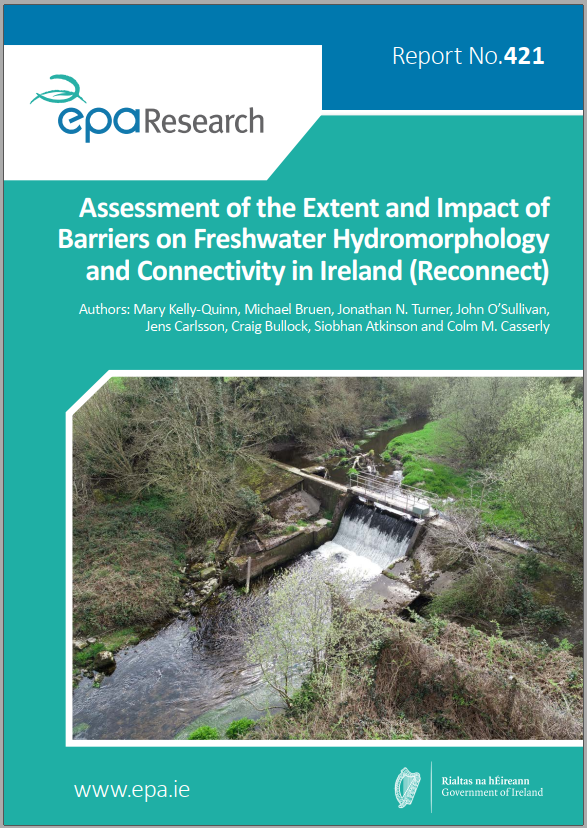Research 421: Assessment of the Extent and Impact of Barriers on Freshwater Hydromorphology and Connectivity in Ireland (Reconnect)
Authors: Mary Kelly-Quinn, Michael Bruen, Jonathan N. Turner, John O’Sullivan, Jens Carlsson, Craig Bullock, Siobhan Atkinson and Colm M. Casserly
Summary: The Reconnect project advanced knowledge on the impact of low-head barriers on connectivity in Irish rivers in terms of sediment dynamics and ecology (fish, macroinvertebrates and macrophytes) through studies undertaken from 2016 to 2020 in four core study areas on the Duag, Dalligan and Burren rivers and Browns Beck Brook and at 35 other locations across 12 river/stream systems. The project also developed a methodology for prioritising barriers for modification or removal to improve hydromorphology and connectivity.

Project Highlights
Watch the project highlights video
Identifying Pressures
Barriers to freshwater connectivity can impact aquatic fauna and ecological water quality as well as Water Framework Directive (WFD) status, either directly or through their effects on hydrological and morphological elements. It is estimated that there are at least 1.2 million instream barriers in Europe, 68% of which are low-head structures such as weirs, fords and culverts. The Reconnect project contributed to efforts to identify the extent of low-head barriers in Ireland by refining a desk study methodology. The desk study largely eliminated the need to walk entire river catchments to locate barriers, allowing more focused site visits, especially in remote locations, where walkover surveys may be especially difficult and time-consuming. This work was followed by surveys of the nature, extent and characteristics of barriers in 10 catchments. The mapped barriers have been added to the national barriers database held by Inland Fisheries Ireland and to the European Atlas of Barriers. Investigations on fish, macroinvertebrates and sediment dynamics in relation to barriers and their removal have highlighted how their presence may impact these elements through restricted movement or declining habitat quality.
Informing Policy
The WFD requires Member States to achieve at least good ecological and chemical status in all surface water bodies. It recognises that physical habitat is critical in terms of aquatic community structure and functioning, and ecological status rating. The key elements of hydromorphological quality supporting the biological elements include hydrological regime, condition of geomorphic elements (e.g. channel morphology, substrate composition, bank condition and sediment transport) and river connectivity. Barriers to freshwater connectivity impact ecological quality through restricted movement of aquatic organisms, best described for fish. They also impact habitat quality due to the creation of ponded areas behind these structures and altered sediment storage and conveyance. The Reconnect project provided an evidence base on the extent and potential impacts of low-head barriers in Irish rivers that will inform policy relating to their potential removal or modification. The results and recommendations will be particularly important in the 2021–2027 river basin planning cycle and policy development to address alterations to hydromorphological conditions.
Developing Solutions
The Reconnect project produced an evidence base on the extent and potential impact of low-head barriers in Irish rivers that can support identification and justification of appropriate, context-dependent solutions to mitigate their impact. Information on the extent and characteristics of low-head barriers have been provided for 10 river catchments. The project also tested and refined a number of tools that can help prioritisation of barriers for removal or modification to improve connectivity and habitat quality. The species-specific environmental DNA (eDNA) quantitative polymerase chain reaction (qPCR) assays that were developed during the project for Atlantic salmon, white-clawed crayfish and shad (allis and twaite) and previously for sea lamprey and pearl mussel proved to be highly effective in assessing the distribution of these target species. They provide a valuable, non-invasive solution for determining the effect of barriers on the species. Finally, a multi-criteria framework that included seven key criteria (cost, flow regulation, heritage value, recreation benefits, sediment, angling/connectivity and river rewilding) for ranking barriers for removal or modification was developed with stakeholder involvement.
https://www.epa.ie/media/epa-2020/research/epa-funded-research/Report-cover-421.png